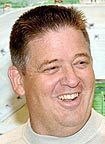Charlie Weis Staff
Football Head Coach

Weis, a 1978 Notre Dame graduate and owner of four Super Bowl-champion rings as products of a stellar 15-season career as a National Football League assistant coach, wasted no time putting his signature stamp on his alma mater’s program in his first two years as Irish head coach in 2005 and 2006. Weis and his Irish followed up a 9-3 record in ’05 and BCS appearance in the Tostitos Fiesta Bowl with a 10-3 overall mark in ’06 and a second consecutive BCS invitation, this time to the Allstate Sugar Bowl. Those 19 combined wins (including eight straight in the middle of the ’06 regular season) qualified as most in a two-year period by the Irish since they collected 21 in 1992-93. It was also the first time Notre Dame played in BCS games in successive years and the most prominent two-season bowl qualification since the Irish played in the Fiesta and Orange Bowls after the 1994 and ’95 campaigns. The only schools to play in BCS games after both the ’05 and ’06 seasons were Notre Dame, Ohio State and USC. Notre Dame’s 10 regular-season wins in ’06 marked the ninth time that figure had been achieved in Irish history. Weis’ 19 combined wins in his first two seasons were the most by a Notre Dame head football coach in his first two years (the previous high was 17 by both Terry Brennan in 1954-55 and Dan Devine in 1975-76). For the second straight season in ’06 Weis was one of three finalists for the George Munger Award presented by the Maxwell Football Club (of Philadelphia) to the college coach of the year.
Irish Post Gaudy Offensive Numbers
The architect in ’05 and ’06 of the two most prolific passing seasons in Notre Dame football history, Weis effectively transformed the Irish offense into one of the most productive in the country, as Notre Dame scored more points in `05 (440) than in any previous season in school history – and also qualified as the most improved offensive attack in the nation, jumping its total offense production (477.33 yards per game) a national-best 131.8 yards per game better than in ’04. The Irish followed that up with another strong passing attack in ’06, with Notre Dame’s average of 264.1 passing yards per contest ranking 13th nationally and second all-time in the Notre Dame record book (behind only the 330.3 mark from ’05). The Irish protected the football nearly as well as any team in the country in ’06, with their 14 overall turnovers in 13 games ranking tied for fourth of the 119 NCAA I-A teams. On a combined basis in 2005 and ’06 under Weis, Notre Dame led the nation in interception avoidance with only 1.6 percent of Irish passes picked off over those two years. The Irish, thanks in large part to the play of quarterback Brady Quinn, finished third in TD passes with 69 and sixth in passing yards per game (295.8) and passing rating (151.7). In ’05 and ’06 combined, compared to the previous two seasons, the Irish improved their points per game by 11.5, and their total yards per game by 90.9. Offensive productivity, coupled with an opportunistic, physical defense that forced eight red-zone turnovers, and vastly-improved special teams, equated to a 9-3 mark in ’05 that was good for a number-six ranking in the BCS final regular-season standings and a guaranteed at-large BCS berth in the `06 Tostitos Fiesta Bowl opposite Big Ten co-champion Ohio State. Notre Dame’s only losses in ’05 came by three points in overtime to then-unbeaten Michigan State, by three points to top-ranked and unbeaten USC on a last-second Trojan touchdown, then to fourth-rated Ohio State in the Fiesta Bowl. The Irish again picked up an at-large BCS position in ’06 after their final 11th-place standing in the BCS poll. Notre Dame’s 10 wins included two of the most dramatic comeback victories in Irish history – a 40-37 win at Michigan State after trailing by 16 points with nine minutes remaining and a 20-17 win over UCLA thanks to a three-play, 80-yard drive that resulted in the winning points with 27 seconds left. Notre Dame’s only defeats in ’06 came at the hands of fifth-rated USC (the Trojans finished 11-2 after winning the Rose Bowl), third-ranked Michigan (winner of 11 straight games to open the ’06 campaign) and fourth-rated LSU (the Tigers finished 11-2). Notre Dame finished ninth in the final Associated Press poll for ’05 (its first AP top 10 finish since the Irish were runnersup following the ’93 season), 11th according to USA Today. The Irish ended the ’06 season rated 17th by AP and 19th by USA Today.
Football Writers Honor Irish Coach
His team’s `05 success helped make Weis winner of the 2005 Eddie Robinson Coach of the Year Award, as national college coach of the year as selected by the Football Writers Association of America. He also was one of three finalists for the `05 Munger Award, one of five finalists for the ’05 Schutt Division I-A Sports Coach of the Year (presented by American Football Monthly) and finished third in the balloting for the AP college football coach-of-the-year award. Weis saw his Irish offense flourish right out of the gate in ’05 — as Notre Dame set a school record by scoring at least 30 points in all but two outings and tied another record by scoring 40 points on six occasions. He helped put a handful of Irish players in contention for major national awards, as Quinn was a finalist for the Walter Camp Player of the Year Award, one of three finalists for the Davey O’Brien Award presented to the top quarterback in the country – and finished fourth in the ’05 Heisman Trophy voting. In addition, consensus first-team All-America wide receiver Jeff Samardzija was one of three finalists for the Fred Biletnikoff Award as the top receiver nationally, as was tight end Anthony Fasaso for the John Mackey Award as the top tight end in the country. Weis’ charges added to that list of individual accomplishments in ’06 – as Quinn won the Maxwell Award as the outstanding player in the country and the Johnny Unitas Golden Arm Award (as the top senior quarterback), took third in the Heisman Trophy race (only the second time a Notre Dame player ever had finished fourth or better in consecutive seasons) and again was a finalist for the O’Brien Award and the Walter Camp Foundation Player of the Year Award. Meanwhile, Samardzija was a Biletnikoff finalist and first-team All-American for the second straight season – and tight end John Carlson was a finalist for the Mackey Award (as well as a first-team Academic All-American). Safety and kick returner Tom Zbikowski won third-team AP All-America honors in both ’05 and ’06.
Quinn A Star Under Weis’ Guidance
Quinn, turned into a star in `05 and ’06 under Weis’ tutelage, as he set 36 career, single-season, single-game and miscellaneous records after breaking 25 in that ’05 season alone. Quinn qualifies as the Notre Dame career and single-season leader in passing yards (3,919 in ’05; 11,762 in his career), pass completions (292 in ’05; 929 in his career) and touchdown passes (37 in ’06; 95 in his career). He ranked third in the country in ’06 with those 37 TD passes (behind only Hawaii’s Colt Brennan with 58 and Texas Tech’s Graham Harrell with 38). He also ranked third in `05 with 32 TD passes (behind only Brennan with 35 and UCLA’s Drew Olson with 34) — and he set an Irish single-game record with his six TD passes versus BYU in ’05. During the middle of the ’06 season, Quinn threw a best-in the-nation 226 consecutive passes without an interception (that streak ended in the 11th game of the season vs. Army). Meanwhile, Samardzija (an ’05 NCAA consensus first-team All-American, based on his selection by The Sporting News and the Football Writers Association of America team – then a first-team pick again in ’06 by the FWAA) finished as runnerup for the ’05 NCAA title in TD receptions with 15. He and Rhema McKnight finished one-two on Notre Dame’s career pass reception chart (with 179 and 170, respectively), after both surpassed Tom Gatewood (he’d held the record with 157 since 1971) during the ’06 season. Meanwhile, McKnight’s 15 TD receptions in ’06 tied Samardzija’s single-season Irish mark from ’05 and ranked him tied for second nationally in that category (behind only Rice’s Jarett Dillard with 21). Samardzija’s season total of 78 receptions in ’06 broke the season mark of 77 he tied in ’05 (Gatewood caught 77 in ’70). Weis guided the `05 Irish offense to final national rankings of fourth in passing offense (330.25 yards per game), eighth in scoring (36.67 points per game) and 10th in total offense (477.33 yards per game). Then, in ’06, the Irish finished 13th in passing (264.1 yards per game) and 16th in scoring (31.0 points per game). In ’07, his pass defense ranked second in the nation in average yards allowed per game (161.6), while defensive tackle Trevor Laws led the nation in tackles by a lineman (112). On an individual basis in `05, Quinn ranked fifth nationally in total offense (334.08 yards per game) and seventh in passing efficiency (158.40 rating points), and Samardzija stood fourth in receiving yards per game (104.08). Quinn in ’06 ended up 11th in total offense (269.0 yards per game) and 19th in passing efficiency (146.66 points). Samardzija in ’05 broke the Notre Dame season marks for receiving yardage (1,249) and TD receptions (15) and tied Gatewood’s 35-year-old single-season record of 77 receptions from ’70, before claiming the single-season reception mark for himself in ’06 and the career pass receiving yards record (2,593) and the career TD reception mark (27). Quinn finished 10th all-time among NCAA I-A quarterbacks in passing yards (11,762), 11th in completions (929) and tied for seventh in TD passes (95).
Weis’ Irish are Passing Fancies
The Irish in 2005 and `06 were easily the two most productive passing teams in Notre Dame history, with their ’05 average of 330.25 passing yards per game shattering the previous high of 252.7 aerial yards per game from 1970 (and the ’06 mark of 264.1 easily breaking the record as well). Notre Dame set another school record by topping the 500-yard mark in total offense seven times in ’05, including a 663-yard performance against Stanford in the regular-season finale that marked the fifth-best single-game effort in the Irish record book. Notre Dame in ’05 became the first Irish team in history to boast a 3,000-yard passer (Quinn with 3,919), a 1,000-yard rusher (Darius Walker with 1,196) and two 1,000-yard receivers (Samardzija with 1,249 and Maurice Stovall with 1,149). Notre Dame in `05 set 11 single-season offensive team records, nine career individual records, 14 season individual records, seven single-game individual records, plus six other miscellaneous records. With the season-opening Irish victories at 23rd-ranked Pittsburgh and at third-rated Michigan in `05, Weis became the first Irish head coach to win his first two career games on the opponents’ home fields since Knute Rockne in 1918 and the first Notre Dame head football coach ever to open with two victories over ranked opponents. The Irish also won at 22nd-rated Purdue in ’05 to post three wins over ranked opponents (all on the road) in their first five games of the campaign. Notre Dame in ’06 added a season-opening victory over a solid Georgia Tech team that eventually finished 9-5 (and 25th in the USA Today final regular-season poll) and played in the Atlantic Coast Conference title game – as well as wins over ’06 postseason participants Penn State (9-4 and 24th in the final AP poll), Purdue (8-6), UCLA (7-6) and Navy (9-4).
Irish Achieve in Classroom as Well
Weis has impacted the Irish program off the field as well, with his football players combining to top the 3.0 grade-point average mark in a record six straight semesters. His players achieved a then-program-record 3.044 combined grade-point average during the ’05 fall semester, with 56 of 97 players earning a 3.0 average or better — and added another 3.0 semester in the spring of ’06 with a program-best 3.072 mark. Notre Dame’s team produced a third-straight 3.0 semester with a 3.041 GPA for the ’06 fall semester — including 61 of 104 players (and 17 of 24 starters, including punter and placekicker) achieving a 3.0 or better average. Ten Irish players were enrolled in graduate studies during the fall of ’06 – five others graduated in December ’06 after only three and a half years of study. Notre Dame produced its first football Academic All-American in 13 years in Carlson in ’06. The fourth 3.0 semester came in spring 2007 with a combined 3.041 GPA (59 players finished at 3.0 or better). Notre Dame’s fifth consecutive 3.0 semester came in fall 2007, with 51 players individually achieving that level or better. Carlson and Laws both were second-team Academic All-Americans in ’07, with Carlson winning postgraduate scholarships from both the NCAA and the National Football Foundation. The 2008 spring semester marked the sixth straight semester with a team GPA over 3.0. Fifty-four members of the team recorded a GPA over 3.0 and 14 players were named to the dean’s list. In addition, Notre Dame received the 2007 Academic Achievement Award (shared with Northwestern) from the American Football Coaches Association – with both schools graduating 95 percent of their freshman classes that entered in 2001. That made Notre Dame a seven-time winner of the AFCA award. Midway through the ’05 season Weis agreed to a new 10-year contract that took effect in 2006 and extends through the 2015 season. He ranked 53rd on The Sporting News Power 100 list of the most powerful people in sports, as the highest-ranked individual associated with college athletics (Jan. 13, 2006, issue of The Sporting News). The Notre Dame Monogram Club presented him with an honorary monogram prior to the ’07 Blue-Gold game. Weis
Begins NFL Tour with Giants
Weis started his professional coaching career with the New York Giants in 1990. After assisting in the Giants pro personnel department while also coaching high school football in `89, Weis a year later was named defensive assistant and assistant special teams coach (under eighth-year Giants head coach Parcells). In his first season on the Giants coaching staff, the Giants claimed the Super Bowl title with a 16-3 overall record. In 1991, Ray Handley took over as coach of the Giants and named Weis his running backs coach. After two seasons on Handley’s staff, Weis began a four-year stint in New England – all four of those seasons under Parcells. In Weis’ first tenure with the Patriots from 1993-96, he assisted in the development of some of New England’s all-time best individual season performances from Coates, Martin and Terry Glenn, respectively. During his first four seasons in New England, he coached three different positions. In 1993 and `94, Weis served as the Patriots’ tight ends coach and, in his second season at the position, Coates set an NFL record for receptions by a tight end with 96 and earned his first trip to the Pro Bowl. In `95, Weis coached the Patriots’ running backs and was credited with developing Martin, a third-round `95 draft pick, into one of the premier running backs in the NFL. That year, Martin won league rookie-of-the-year honors and set franchise rushing records with 1,487 yards and 14 TDs. In `96, Weis coached the New England receivers, with Glenn leading the team and setting an NFL rookie reception record with 90 catches for 1,132 yards and six TDs. From 1997 to ’99 (with Parcells as head coach and Belichick as assistant head coach), Weis called offensive plays for the New York Jets. In his first season, the Jets improved from 1-15 in 1996 to 9-7 in `97. The eight-game improvement ranked as the best in franchise history. In `98, Weis was named the offensive coordinator/wide receivers coach. By season’s end, his offense ranked among the greatest in franchise history and led the Jets to their first division title. The team scored 416 points, second-highest total in franchise history (after 419 points in `68) and averaged 357.2 yards per game. It marked the second-best total-offense season average in Jets history (368.5 yards per game in `85). Both of Weis’ starting receivers, Johnson (1,131) and Wayne Chrebet (1,083), eclipsed the 1,000-yard receiving plateau for the first time in their careers. It marked the first time since `86 that two Jets receivers reached that milestone in the same season. In `99, Weis’ offense produced the NFL’s second-leading rusher and the AFC’s fourth-ranked receiver. Martin rushed for 1,464 yards, falling only 90 yards shy of the rushing title (won by Indianapolis’ Edgerrin James). Johnson led the Jets and established career highs with 89 receptions for 1,170 yards, earning his second consecutive Pro Bowl nod.
Hannah & Friends Enjoys Wide Support
In the spring of `08, the fifth annual Hannah & Friends Celebrity Golf Classic was held in South Bend to benefit the foundation. Weis also joined with former Notre Dame football coaches Ara Parseghian and Lou Holtz in a dinner the past three summers to benefit the three coaches’ charitable interests. The Notre Dame Coaches’ Kickoff for Charity was first held in 2006 in New York City, then was followed by the 2007 dinner in Beverly Hills, Calif. Chicago hosted the most recent fundraiser on July 31, 2008. Weis is the author of a 2006 autobiography (written with Vic Carucci) titled [quote]No Excuses: One Man’s Incredible Rise Through the NFL to Head Coach of Notre Dame.[quote] His wife, Maura, is author of a 2008 book (written with Jessica Trobaugh Temple) titled [quote]Miles from the Sideline[quote] – a journey with the Weis’ special needs daughter. Weis traveled to the Middle East (Bahrain, UAE, Qatar, USS Nassau) in the spring of ’08 with a contingent of college football coaches to visit United States military troops. Charlie and Maura have two children, Charles Joseph and Hannah Margaret.







